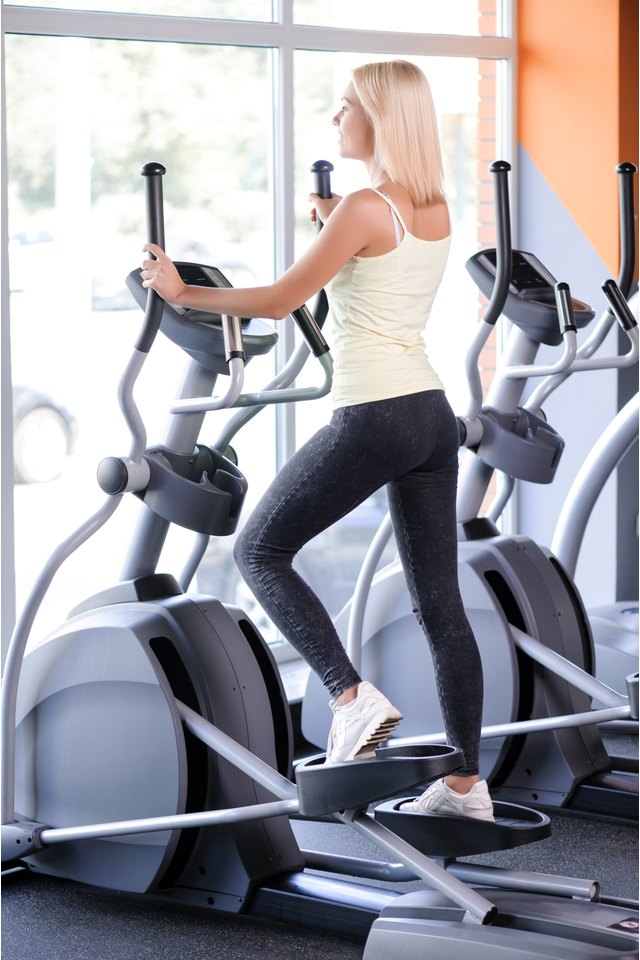What does fact checked mean?
At SportsRec, we strive to deliver objective content that is accurate and up-to-date. Our team periodically reviews articles in order to ensure content quality. The sources cited below consist of evidence from peer-reviewed journals, prominent medical organizations, academic associations, and government data.
The information contained on this site is for informational purposes only, and should not be used as a substitute for the advice of a professional health care provider. Please check with the appropriate physician regarding health questions and concerns. Although we strive to deliver accurate and up-to-date information, no guarantee to that effect is made.
Can I Use the Elliptical With Iliopsoas Bursitis?

Iliopsoas bursitis is an inflammation of the bursa, or fluid-filled sac, located under the iliopsoas muscle. The iliopsoas muscle lies in front of your hip joint and attaches to the top of your thigh bone. The condition is usually caused by repetitive motion; dancers, runners and gymnasts are particularly susceptible. Physical therapy -- particularly the use of strengthening and stretching exercises -- plays an important role in recovery from iliopsoas bursitis. However, exercising can cause further injury if undertaken too soon. A physical therapist can evaluate your condition and recommend an exercise program, including an elliptical machine.
Iliopsoas Features
The iliopsoas muscle, technically a pair of muscles, is composed of the iliacus and psoas muscles. It lies in front of the hip joint and attaches to the thigh bone by way of the iliopsoas tendon; its function is to flex the hip and bring the leg out in front. The bursa of the iliopsoas, which serves to cushion the hip joint and helps to reduce friction, is located between the tendon and the hip joint.
Iliopsoas Bursitis Features
Iliopsoas bursitis is indicated by pain and tenderness deep in the groin and radiating around to the upper thigh; you may also experience stiffness and tightness of the groin, along with warmth, redness and swelling. A snapping or popping sensation in the hip also indicates bursitis. According to an article published in 2003 in "Journal of Family Practice," pain is usually intensified when walking up and down stairs. If you have extreme joint pain, pain lasting more than one to two weeks, excessive swelling or bruising, severe shooting pain, or a fever, Mayoclinic.com warns that you should call your doctor. Physicians treat iliopsoas bursitis with anti-inflammatory medications; in severe cases, they may advise corticosteroid injections. Abstaining from the activity that caused the bursitis in the first place is essential to recovery.
Benefits of Physical Therapy
Physical therapy can restore function, strengthen weakened muscles and help to establish full range of motion, according to the Merck Manuals. Aidmybursa.com advises stretching, strengthening and conditioning exercises to help to regain flexibility and prevent scar tissue from forming. To prevent the iliopsoas muscle from pulling the pelvis out of alignment, it is important to strengthen the opposing muscles as well.
Elliptical Machine for Iliopsoas Bursitis
Working out on an elliptical machine, a stationary exercise machine operated by pedals that describe an oval shape, can be an effective form of physical therapy for iliopsoas bursitis. Michael A. Yorio, M.D., a physician specializing in sports medicine in Hyde Park, New York, notes that an elliptical machine can be utilized in iliopsoas bursitis recovery as a method of cross-training, and can be alternated with running, biking and swimming. Edward R. Laskowski, M.D., Mayo Clinic rehabilitation specialist, says that the elliptical machine places less stress on the hips, back and knees than a conventional treadmill. This low-impact feature makes it particularly appropriate for individuals who have experienced a repetitive motion sports injury. However, before work on the elliptical can begin, your physical therapist may recommend several weeks of stretching and strengthening exercises; return to full activity should be gradual.
References
- Merck Manuals: Bursitis
- Beginner Triathlete: Iliopsoas Bursitis
- Mayoclinic.com: Elliptical Machines: Better Than Treadmills?
- Laible C, Swanson D, Garofolo G, Rose DJ. Iliopsoas syndrome in dancers. Orthop J Sports Med. 2013;1(3):2325967113500638. doi:10.1177/2325967113500638
- Laible C, Swanson D, Garofolo G, Rose DJ. Iliopsoas syndrome in dancers. Orthop J Sports Med. 2013;1(3):2325967113500638. doi:10.1177/2325967113500638
- American Academy of Orthopaedic Surgeons. Hip bursitis.
- American College of Rheumatology. Tendinitis and bursitis. Updated March 2019.
- American Academy of Orthopaedic Surgeons. Hip bursitis. Updated September 2018.
- Physiopedia. Iliopsoas bursitis.
- Musick SR, Varacallo M. Snapping hip syndrome. StatPearls Publishing. Updated April 16, 2019.
- Cleveland Clinic. Tendinitis. Updated February 12, 2020.
Writer Bio
Carol Sarao is an entertainment and lifestyle writer whose articles have appeared in Atlantic City Weekly, The Women's Newspaper of Princeton, and New Millennium Writings. She has interviewed and reviewed many national recording acts, among them Everclear, Live, and Alice Cooper, and received her Master of Fine Arts degree in writing from Warren Wilson College.
